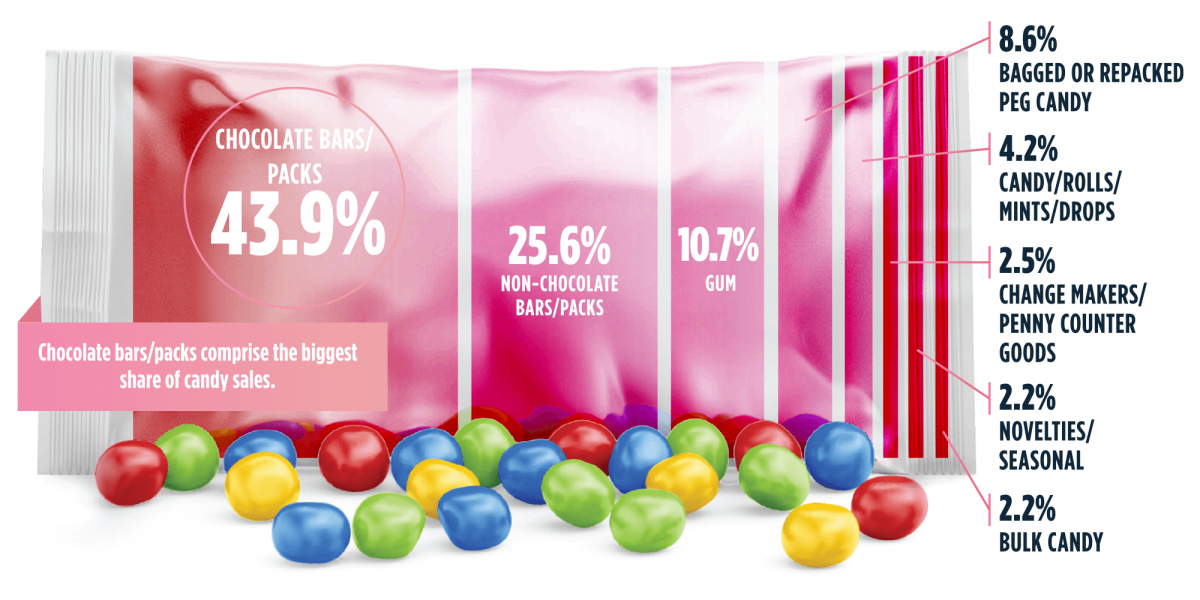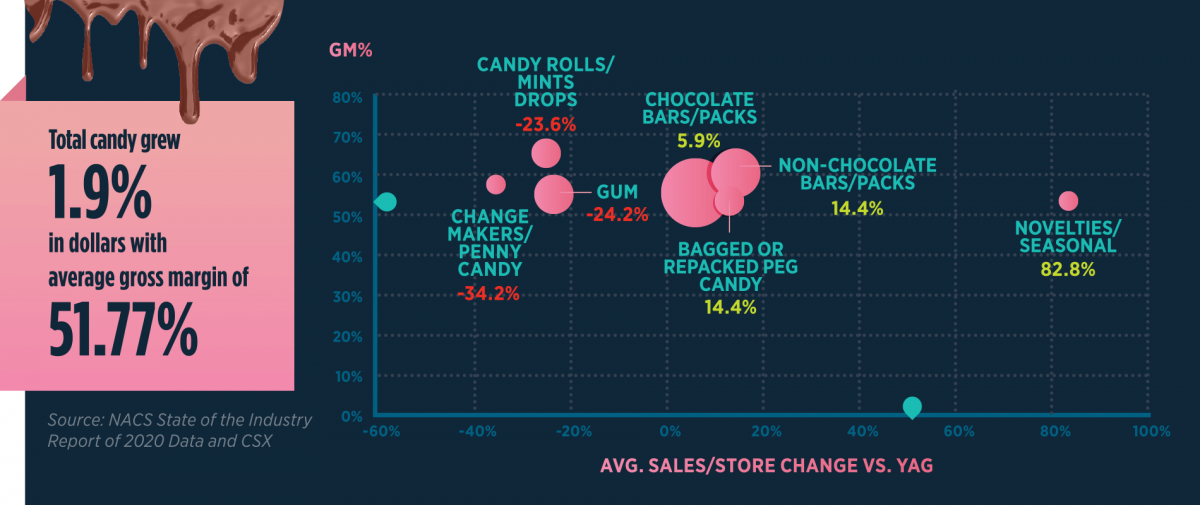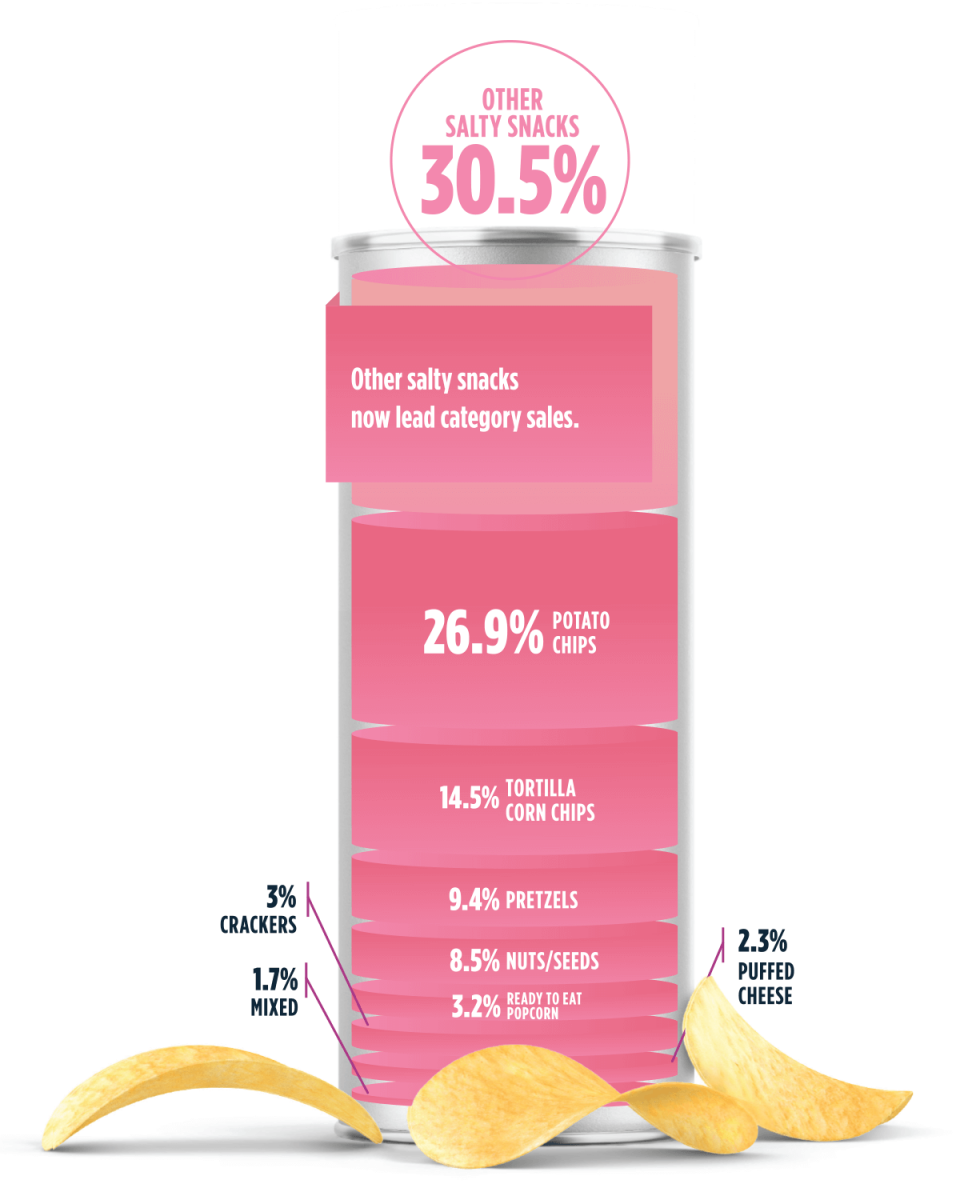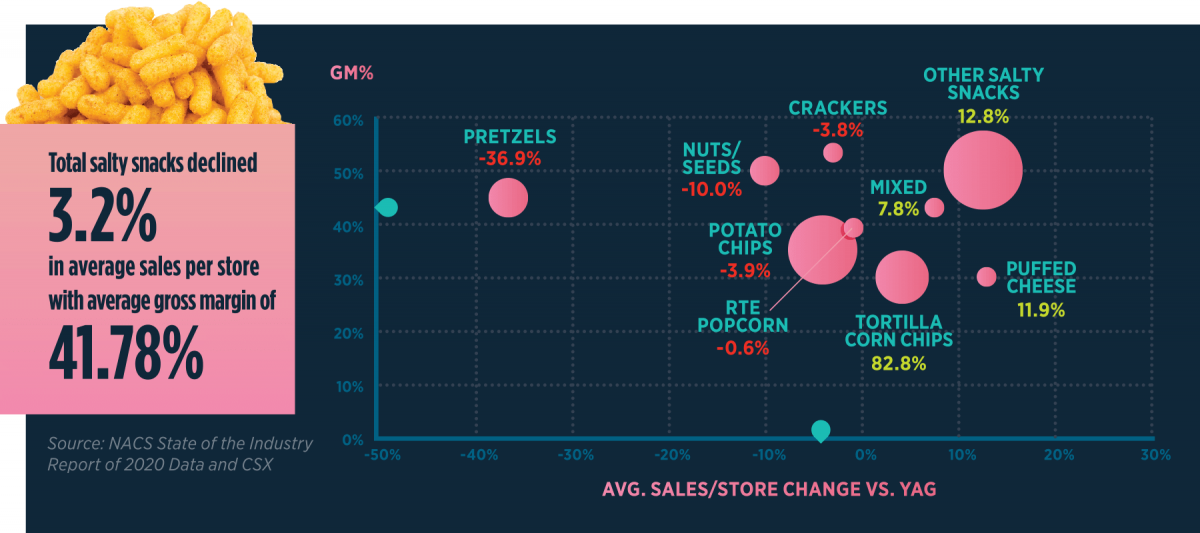The coronavirus pandemic heightened many retail trends, such as more online shopping, payments with apps or mobile wallets and home deliveries of takeout meals and groceries. What didn’t change was consumers’ desire for self-indulgent treats, according to NACS State of the Industry (SOI) data.
Bagged candy experienced a 12.8% sales bump last year.
“We saw a great increase in candy as people were taking more time to treat themselves to that extra chocolate bar or buying bigger packs to take home and share with their family,” said Kelley Gutierrez, category manager for candy and snacks at MAPCO Express Inc., which operates more than 345 stores largely in the Southeast U.S. For example, chocolate bars and larger packs continue to dominate sales within the candy category. “At MAPCO, we saw innovation driving performance and shopper preferences widening to where they sought new and exciting options within the candy segment,” she said. “Similar to candy, the demand for larger pack types impacted the overall sales within salty snacks,” Gutierrez said.
Here’s how these two categories did in 2020—and how retailers can continue the momentum into 2021 and beyond.
Satisfying a Sweet Tooth
Candy continued to be a powerhouse performer in the convenience channel, grabbing 2.95% of in-store sales and 4.34% of in-store gross margin contribution, according to NACS SOI data for 2020.

“Candy is typically a higher margin product that is used as a basket builder and has a high affinity to many other categories, such as packaged beverages, fountain drinks and foodservice,” Gutierrez said. Candy sales grew 1.9% in dollars, delivering an average gross margin percentage of 51.77%.
At MAPCO, bagged and repackaged peg candy snagged Gutierrez’s attention. “Many other category and merchandising teams I’ve spoken with have also seen massive demand for bagged candy, speaking to consumers buying it to share with others or for special at-home moments, rather than for immediate consumption,” she said. Bagged candy experienced a 12.8% sales bump last year.
Overall, innovation in the candy aisle is building excitement in the category. “People are still looking for those standard indulgent treats that they’ve come to know and love,” she said. Chocolate continues to lead as a decadent treat, while gummies and sours spurred growth in bagged candy.

One subcategory hurt by the loss of commuter traffic has been candy rolls, mints and drops. “We’ve had a really tough year within the gum, mint and drops category because of the reduction in trips,” Gutierrez said. With not as many people going out or interacting face-to-face with co-workers, there has been a 23.6% decline in average store sales for candy rolls, mints and drops and a 24.2% drop in average store sales of gum.
Pandemic shopping behavior has opened the door to new category considerations for candy, such as expanding bagged or repackaged peg candy to deliver more variety and meet the price-conscious shopper’s needs. Consolidated trip frequency hints at the consumer need for multiserve portions and purchases of multiples at one time.
Novelties represent an area of growth potential for retailers. Novelties and the seasonal segment showed 82.8% growth over 2019. “We noticed people still wanted to celebrate the little moments by grabbing a couple of candies for families or friends,” she said. “Seasonal items that are limited-time only can drive customers into your store, so executing them prior to holidays will allow your customers to know you are a destination for those items.”

Snack Attack
Salty snacks sales declined last year. The category represented 4.27% of in-store sales and 4.84% of gross profit dollars, according to NACS SOI data. “New priorities for salty snacks have emerged in a post-COVID world,” Gutierrez said. For example, there are increased options within growing flavor segments. “We’ve seen the hot and spicy flavor segment blow up,” she pointed out.
In addition, as with candy, fewer trips translated into consumers buying more multiserve portions and value-based multiples offers. “Since people are shopping less frequently, I want them to come to my store to purchase their take-home sizes of chips, so we will entice them with a twofer promotion,” Gutierrez said. “That’s very competitive with your local grocer or drugstore, and it’s a great way to get repeat business from people who want a quick alternative to the grocery store but still want those larger pack types at a great value price.”

Shoppers are also snapping up better-for-you options in salty snacks as they embrace new eating lifestyles. For example, the popcorn and pretzel segments are seeing new innovation with potential for share growth, and mixed snacks have been showcasing more intense flavor profiles. “While popcorn and pretzels haven’t done well lately, they’re going to bounce back in 2021 because of the innovation and flavor profiles coming out,” she said.
MAPCO leverages cross-category marketing to drive basket sales that include salty snacks. “Are you calling out to the customer coming in for a soda about your salty snacks? Are you using your cooler doors and other prime signage points to grab attention to your salty snack promotions? All of these working together will increase salty snack sales,” Gutierrez said.
For example, twofer offers build bigger baskets, while promotions on larger packs can incentivize shoppers to skip the grocery store. Keep an eye on the calendar to capitalize on holidays and other special events to tie into seasonal promotions. “For MAPCO, car racing events can be huge for us,” she said. “We make sure we have extra products in stores near stadiums on race days.”
Overall, candy and salty snacks will continue to provide opportunities for retailers who recognize how customer behavior has changed because of the pandemic. “Those who tailor their promotions to serve new-to-convenience-store guests and adjust their assortment to offer in-demand pack sizes will be well positioned to grow these category sales well into 2021,” Gutierrez said.
